computers in libraries conference
March 28-30 preconference workshops March 27 hyatt regency crystal city
arlington, va
W5: Want Media Coverage? Add Press Room to Your Website
9:00 a.m. – 12:00 p.m.
Kathy Dempsey, Editor, Marketing Library Services newsletter Owner, Libraries Are Essential consultancy
Library marketers crave media attention and coverage, but most don’t know how to get it. The first step is having a Press Room as part of your library’s website. This workshop, led by a member of the media who’s also a library marketing expert, shows you how to build a Press Room that works. It includes how your library benefits from having an online Press Room, even if you don’t have a marketing department; where it belongs in your website hierarchy; what content members of the press expect to find there; SEO basics and PR tactics to lead reporters to your online Press Room; why building relationships with the media is vital; how press coverage affects your library’s usage, funding, brand recognition, and position in the community. Help ensure positive coverage by adding this strategic tool to your website.
W8: Video: Hands-On Learning & Practice
9:00 a.m. – 12:00 p.m.
In this half-day workshop, a former advertising executive and trainer of strategic storytelling in marketing shares secrets on how to create video that has an impact on your community. Join her to shoot, edit, and polish a video while gathering tips, techniques, and strategies to create your own video-a medium which grabs communities in exciting new ways!
W10: Implementing an Internet of Things Infrastructure & Apps
9:00 a.m. – 12:00 p.m.
May Chang, Assistant Director, LibraryTechnology, East Carolina University
The Internet of Things (IoT) is becoming widespread in academia as well as industry. It refers to connecting smart objects with built-in unique identifiers and sensors to communicate with each other autonomously. This enables actionable insights and ultimately makes the environment around us smarter. This workshop looks at how libraries can incorporate the IoT and reviews different aspects of developing an IoT infrastructure and creating your own application. It is based on four layers of IoT application architecture: the physical layer, the communications layer, application and services layer, and data analytics. Speakers discuss the potentials and challenges of IoT applications, including the footprint of IoT applications, i.e., a high volume of sensory data, the tools and methods for data analytics. As a case study, they focus on location-aware applications using iBeacons and smartphone sensors to show how all the IoT elements work together. Gain a better understanding of the usefulness of IoT in libraries, learn the main elements and underlying technologies of IoT applications, and understand the difference between a wide range of IoT devices, protocols and technologies to choose the right ones for your IoT application. Get budget and resource estimates and more. Come with a basic understanding of JavaScript/ HTML5/ CSS and your laptop for hands-on development practice. An instruction document will be provided for the attendees to prepare their system before the workshop.
W15: Tech Trends for Libraries in 2017 & Beyond
1:00 p.m. – 4:00 p.m.
David Lee King, Digital Services Director, Topeka & Shawnee County Public Library and Publisher, davidleeking.com
Technology has changed the face of libraries and is continuing to change how we work and how we deliver services to customers. This workshop introduces emerging technology trends and shows how those trends are reshaping library services. Examples are provided of how to incorporate these evolving trends into libraries. Attendees learn what trends to look for, find out the difference between a technology trend and a fad, and get ideas on how their library can respond to technology as it emerges.
W16: UX Design for Broader Discovery
1:00 p.m. – 4:00 p.m.
Amy Luedtke, Senior Librarian, Information Programs and Services, Hennepin County Library
While patrons have embraced using online technology to access their public library, most of these interactions are limited to borrowing transactions. If libraries are to be truly relevant in the digital world, we need to nudge patrons out of the well-worn pattern of log-in/transact /log-out and find ways to get them to linger long enough to discover the richness the library has to offer beyond borrowing items, while offering them opportunities to add their own voice to the library’s online community. This workshop explores design patterns and techniques for introducing content to patrons at appropriate moments in their learned workflows. It considers how to encourage patrons to add their voice to the library community and overcome concerns about privacy and security. It shares research and experience from BiblioCommons and Hennepin County Public Library’s efforts and looks at analogs from other domains. Workshop participants will be asked to participate actively in a hands-on session to solve a specific design challenge in teams.
My note: Ha. Even the public library understands that service goes beyond “borrowing items” and must have “patrons to add their voice.” Only in the academic library, prevails the opinion that librarians are those omnipotent and all-knowing lecturing types.
B103: Website Redesign: Techniques & Tools
1:15 p.m. – 2:00 p.m.
Dana Haugh, Web Services Librarian, Stony Brook University
Roy Degler, Associate Professor, Digital Library Services, Digital Resources and Discovery Services, Oklahoma State University
Join three web experts to learn about tips, tools, and techniques for taking the pain out of website redesigns. Haugh provides advice on the visual design of your next site and shows some examples of library web redesigns. Degler takes a look at why many libraries are using popular, free, CSS-based frameworks such as Bootstrap; explains how the grid layout works; and shows how the built-in responsive design layouts can deliver a site that works on desktop, smartphones, and tablets. Often the biggest challenge in redesign isn’t the visual design, content management system or coding. It’s the people and politics. Everyone thinks they know what the library website should look like, but no two people—let alone groups—can ever agree. How do you move ahead with a library redesign when you’re facing conflicting demands from the administration, co-workers, users, and stakeholders? Mitchell tackles this challenge head on and points out the weapons that we have at hand—from data to documentation; and discusses how to wield those weapons effectively to win (almost) any fight in order to build a great website. Grab lots of insights and ideas from this experienced panel.
C102: Digital Literacy & Coding Program Models
11:15 a.m. – 12:00 p.m.
Karen Walker, E-Services & Digital Access Manager, Jacksonville Public Library
Brandy McNeil, Associate Director – Tech Education & Training, The New York Public Library
Steven Deolus, Technology Training Program Coordinator, TechConnect (Technology Training Program Department), The New York Public Library
This session looks at how one library created a technology class and programming model that spans a 21-branch, 844-square-mile library system. It discusses mobile classrooms and how Chromebooks, MacBooks, tablets, and other equipment are used to create “classrooms” throughout the system. It shares how the library is focusing on members and programming for the community, for instance, the development of Spanish language, 50+ and immigrant/refugee programming. It looks at developing new programs and instructors using the 3D model from printer to pens, from tablets to coding, from core expertise to everyone. NYPL speakers discuss how coding is the new black! They discuss how to launch a coding program at your library, how to expand the age range of current coding programs, how to promote events related to your program to gain participants, how to get staff buy-in, how to educate staff, and how to create partnerships with some of the biggest names in the game. The NYPL Tech- Connect program will help you plan out all your needs to take your existing or non-existing coding programs further.
My note: one more proof that digital literacy is not “information literacy dressed in the new verbal cloth” of “digital literacy,” but entails way more topics, skills and knowledge. Information Literacy is a 1990s concept. Time to upgrade to 2016 concepts and recognize that digital literacy requires skills beyond handling information. Moreover, information today is way more complex then the skills being taught, since information from social media is more complex then information from news media and it entails technology skills, which one does not have to preside upon for handling news media
E104: From Textbook to Activism: Engaging Students in Social Issues They Care About
2:15 p.m. – 3:00 p.m.
Anna Gray, Social Studies Teacher, Eureka High School, Eureka, Mo.
recent collaborative effort between a high school social studies teacher and a school librarian transformed a “same-old” unit on social movements in the 20th century into a dynamic study of effective social activism—and how students can become effective activists. Using both primary and secondary resources, students learned to analyze social issues, then to identify the type of activism that proved effective for those issues. Next, students selected social situations important to them, analyzed the changes they sought to effect, and determined a means of activism to effect that change in practical—and often surprising—ways. The project’s design and implementation is straightforward and replicable. This session provides concrete steps to follow, specific patterns for locating learning resources, and reproducible forms that educators can carry back to their own campuses.
B202: Managing Tech & Innovation
11:45 a.m. – 12:30 p.m.
Jen Baum Sevec, Senior Metadata and Acquisitions Librarian, Library Of Congress
Brett Williams, Systems & Liaison Librarian, University of Toronto Mississauga
Sevec offers leaders at any level the opportunity to up their game by learning current management strategies for technology and innovation. Library leaders and constituents engage in the nearly constant interplay of enabling technology and innovations to explore a wealth of information and greater depth of data in the Information Age. A framework for managing this interplay is provided as well as an understanding of the dynamic lifecycle inherent in technological innovations and constituent demands. Williams provides an introduction to Wardley Value Chain Mapping, an innovative IT planning processes discussed by Simon Wardley on his blog Bits and Pieces. He shares specific examples of how this tool can be used by systems librarians, library administrators, and library IT decision makers.
B203: Finding Your Social Media Voice
1:45 p.m. – 2:30 p.m.
Kirsten Mentzer, Technology Specialist, Northern Virginia Community College’s Medical Education Campus
Alexandra Radocchia Zealand, Web Editor, New Media Developer and Video Producer, Web Team, Arlington Public Library PLA, VLA, ALA, LLAMA
Lennea R. Bower, Program Specialist, Virtual Services, Montgomery County Public Libraries
This session provides an in-depth look at how to speak in social media. Each institution and organization’s social media accounts has a personality. How you say something is just as important as what you say and why you say it. Your voice on social media says a lot to your followers. If done well, your tone will help to attract and keep an audience. The wrong kind of voice will turn people away. Finding the right voice can be difficult and involves a lot of trial and error. Speakers provide tips for finding the right voice and presenting the best personality for your intended followers. Social media is no longer the “new kid on the block,” and the panel highlights the best ways to communicate content, being real, tone, and more. They showcase what kinds of tones can be used and how to find the “real voice” for your accounts, why those voices are (or are not) successful for those accounts; and how to make your chosen voice sustainable and consistent across your accounts.
C203: Migrating & Developing With Drupal
1:45 p.m. – 2:30 p.m.
June Yang, Senior Librarian, International Monetary Fund
Elizabeth Zoby, Information Specialist, PAE, National Institute of Corrections (NIC)
Billy Mathews, Web Developer, PAE, National Institute of Corrections (NIC)
Migrating to a new ILS system is not easy, and it is even more challenging when faced with a very tight deadline. Presenters share the recent experience of migrating from SirsiDynix Symphony to Alma within 5 months: what worked, what didn’t, lessons learned, and what to prepare in advance of the migration. They also share some insight about post migration work related to data cleanup, workflows review, etc. Zoby and Mathews share their development of the NIC micro-sites using Drupal, an open-source content management software, to create dynamic websites that make accessing material easy and user-friendly. Instead of having to download and shift through large PDF documents, users can access the content on easily searchable websites which can be edited by authorized users. See how the NIC Information Center is using these sites to help customers and the public access information in innovative ways.
D202: Funding Opps for Digital Library Initiatives
11:45 a.m. – 12:30 p.m.
Trevor Owens, Digital Archivist, Office of Strategic Initiatives, Library Of Congress
Nicole Ferraiolo, Program Officer, Scholarly Resources, Council on Library & Information Resources
Joel Wurl, Senior Program Officer, National Endowment for the Humanities
Discovering and deciphering guidelines for grant programs is a daunting and challenging process. This session provides an opportunity to directly hear from and ask questions about grant opportunities for digital libraries’ initiatives to program officers from different government and private funders. Following brief overviews of the relevant funding opportunities at their organizations, panelists discuss the kinds of projects that best fit their specific programs. Get suggestions on how to develop a competitive proposal and insights on the application and review process. Panelists consider themes and trends from the digital library projects that have received funding, such as digitization, open educational resources, linked data, crowdsourcing, open access publishing, emulation and virtualization, and data visualization. By bringing together representatives from different funders, this session offers a unique opportunity to connect directly with program officers and identify new opportunities and approaches for funding.
A301: Augmented Reality & Learning
10:45 a.m. – 11:30 a.m.
Ashley Todd-Diaz, Head, Special Collections & University Archives, Towson University
Earl Givens, Head, Systems & Technology, Catawba College
Art Gutierrez, Head, Technical Services, Emporia State University
Just when you thought the battle of augmented reality (AR) was over with Pokémon GO, libraries across the nation have been exploring additional AR options in order to meet the needs of the mobile learners walking through their doors. With the use of free AR software, four individuals team up to become the ultimate masters of AR. Hear from a panel of closely networked professionals, each with a unique story of embedding AR into specific library services directed for higher education. These stories range from embedding AR with liaison departments to incorporating AR into information literacy sessions (both online and face-to-face).
A304: Multimodal Learning: From Textbooks to Playlists
2:45 p.m. – 3:30 p.m.
Colleges, universities, and libraries are considering adding video making, or visual literacy, as a core skill. Preparing individuals for a highly visual communication landscape requires critical thinking to offset consumerism as well as multimodal learning and cognitive skills. Researching, creating, and sharing video playlists are important ways to create personalized learning pathways and promote continuous learning. Explore a number of case studies that demonstrate the positive learning outcomes of multimodal learning in academic and corporate settings and discover how to create playlists that can be annotated, edited, and shared across teams.
B304: Raspberry Pi
2:45 p.m. – 3:30 p.m.
Raspberry Pi is an inexpensive computing tool that is ideal for new projects within libraries. It’s a powerful single board computer that plays high-definition video, yet it’s only the size of a credit card. The Raspberry Pi 3 was released in February of 2016, and the built-in networking options make it an exciting fit for library applications. Learn how Raspberry Pi can be used as a people counter, a dedicated OPAC, a social media tool, and more.
D302: Upping Our “Gamification”: Speaking Millennials’ Language
11:45 a.m. – 12:30 p.m.
David Folmar, Emerging Technology Librarian, Main Branch, Richmond Public Library Author, Game It Up! Using Gamification to Incentivize Your Library
Be tech-smart and culture-savvy by using game-design thinking and gaming activities to connect with current users in a fun way and draw in new ones. Hear from a library communicator who literally wrote the book on this topic. Online games are incredibly popular; libraries, book apps, and learning institutions are leveraging this to bring in new audiences and engage with existing ones in new ways. Why are they doing this, what is the benefit, and how do you make it work to promote your library? Get the answers here!
D303: Library Story in Video
1:45 p.m. – 2:30 p.m.
Video is a powerful, emotional storytelling medium that plays well in social media, and its use is still fast-growing. Video can spread your library’s story, and you can do it without hiring an expensive pro. A tech-savvy info pro shares basic video facts, along with her favorite tools, tips, and techniques that almost anyone can use for creating short, compelling videos to promote library services, staffers, and resources.
My note: my mouth ran dry to repeat this to the SCSU library. In vain. 1. make a low-cost social-media type of movie of 30 sec each week/month. 2. post on a prominent place on the library web page. 3. Have web form harvest info from patrons on the issu[s] reflected in the video 4. mirror video on the social media 5. aim as ultimate goal patrons (students, faculty, staff) furbishing the video footage instead of library staff
Why is it soooo difficult to comprehend?
E302: Zero to Maker: Invention Literacy & Mobile Memory Lab
11:45 a.m. – 12:30 p.m.
Colleen Dearborn, Adult Services Librarian, Alsip-Merrionette Park Library, Alsip, Ill.
Invention literacy is not just about understanding how a thing is made or how it works; it is also the ability to use that knowledge to bring one’s own ideas into reality. China gives examples of how one public library is empowering children, teens, and adults to become “invention-literate” through its maker programming. Find out how a combination of high- and low-tech equipment, safe and accessible learning environments, and a unique community partnership is nurturing invention, creative confidence, innovation, and entrepreneurship. Sparked by the CIL 2016 Hawkins and Mears talk about personal digital archiving and the DCPL Memory Lab, Dearborn shares her library’s inexpensive journey to create a mobile memory lab program. She discusses the acquisition of equipment and technology, the demo classes, lesson plans about personal archiving, outreach to other community organizations, and providing classes on related topics, such as saving and uploading images, backing up files and using cloud storage, writing and self-publishing memoirs, conducting oral interviews with veterans and other family memories, coding and saving memories on a website, etc. Future plans include digitizing local history documents, a community website with links to these documents, as well as to our patrons’ digitized images, videos, interviews and memoirs.
+++++++++++++++++++++
more on technology in library in this IMS blog
https://blog.stcloudstate.edu/ims?s=technology+library
purpose: draft a document for the provost to plan for charting the future goal 3.12 “develop a comprehensive strategy to increase awareness and development of e-textbooks and open educational resources (OERs)”
\\STCLOUDSTATE\HuskyNet\DeptFiles\LRS\ETextbooks
SCSU goal: to reduce the cost of textbooks as an affordable learning initiative. Amount of reduction is undetermined
my notes based on the material below:
- best, most applicable source for the purpose of this research: U of Alberta Committee’s notes on the learning environment:
http://www.governance.ualberta.ca/en/GeneralFacultiesCouncil/CommitteeontheLearningEnvironm/~/media/Governance/Documents/GO05/LEA/15-16/WEB/Item-4-eTextbook-Subcommittee-Report-CLE-TLAT.pdf
the Canadians are using (citing) Acker (Ohio) in their research.
- best, most applicable source in terms of the logistics on e-texbooks creation and its pedagogical argumentation is this document from New Zealand: https://akoaotearoa.ac.nz/download/ng/file/group-7/guidelines-for-developing-interactive-etextbooks-on-net-tablets.pdf
- According to Bossaler et al (2014), it might be worth considering that SCSU (MnSCU?) must go first through implementing of e-text[books] in courses first by using publisher materials and then by using “in-house” produce. At this point, SCSU does NOT have an aligned policy of integrating e-texts in courses across campus. Lack of such experience might make a strategy for adoption of e-textbooks much more complex and difficult to implement
- stats are colored in green for convenience. Stats regarding the increase in textbook costs are re-printed from author to author: e.g. Acker (2011, p. 42). Murey and Perez (2011, p. 49 (bottom) – 50 (up)) reports stats from 2009 and projections for 2013 regarding etexbook adotion. Same authors, p. 50 second paragraph reports good stats regarding texbooks’ price increase : US$1122 per year for textbooks in 2010.
- Wimmer at al (2014) presents a lucid graphic of the structure of the publishing process (see bottom of this blog entry for citation and perm link).
- Wimmer at al (2014) discusses copyright and permissions, which is of interest for this research (p. 85)
- regarding in-house creation of e-textbooks, see (Distance education, e-learning, education and training, 2015). It very much follow the example of SUNY, which Keith was laying out: a team of faculty charged with creation the e-textbook for mass consumption.
Besides the SUNY model Keith is envisioning for MnSCU (comparable), there is the option of clustering OER sources: e.g. NASTA as per Horejsi (2013), CourseSmart. FlatWorld Knowledge (Murrey and Perez, 2011) etc.
- Hamedi & Ezaleila (2015) present an entire etextbook program. Article has been ordered through ILL. Same with Joseph (2015).
- Open Educational Resources in Acker (2015, p. 44-47). Also in Murey and Perez (2011, p. 51).
Also in ICWL (Conference) (13th : 2014 : Tallinn, E., & Cao, Y. (2014): OpenDSA
- Different models of pricing also in Acker (2015, p. 48). Keith touched on that
- students learn equally well from etextbooks as from paper ones: Taylor (2011)
- pedagogy
responses from colleagues:
Scott Robison, sarobison@mail.plymouth.edu: sparc-liboer@arl.org listserv
Jeff Gallant, Jeff.Gallant@usg.edu: David Ernst with the U and Ashley Miller from Ohio State U: dernst@umn.edu. Ashley’s is miller.6275@osu.edu.
definition e-textbook and
an electronic version of a printed book that can be read on a computer or handheld device designed specifically for this purpose.
-
a dedicated device for reading electronic versions of printed books.
Definition of: e-book
my note: there is no good definition about e-textbook in terms of the complexity, which e-textbook on campus might involve.
Considering Wimmer et al (2014) account on their campus experience in publishing e-textbook, a textbook may involve an LMS (Canvas) and blog (WordPress). Per my proposal during the F2F meeting, and following Rachel’s suggestion about discrimination of the different types of e-textbooks, here is an outline of e-textbook definition:
*******************
working definition for e-textbook for the purposes of SCSU:
e-textbook is a compilation of textual, multimedia and interactive material, which can be viewed on various electronic devices. E-textbook can: 1. be purchased from a publisher; 2. compiled in HTML format on faculty or group web space; 3. compiled on the content module of LMS (BB, D2L, Canvas, Moodle, etc.) 4. compiled on LMS (BB, D2L, Canvas, Moodle, etc.) and including all interactive materials: e.g. hyperlinks to MediaSpace multimedia, quizzes, etc.; 5. compiled on special apps, such as iBook Author, eCub, Sigil.
*******************
e-book
(Electronic-BOOK) The electronic counterpart of a printed book, which can be viewed on a desktop computer, laptop, smartphone, tablet or e-book reader (e-reader). When traveling, a huge number of e-books can be stored in portable units, dramatically eliminating weight and volume compared to paper. Electronic bookmarks make referencing easier, and e-book readers may allow the user to annotate pages.
Although fiction and non-fiction books come in e-book formats, technical material is especially suited for e-book delivery because it can be searched. In addition, programming code examples can be copied, which is why CD-ROMs that contained examples or the entire text were often packaged inside technical paper books.
E-Book Formats
Wimmer, Morrow, & Weber: Collaboration in eTextbook Publishing
There are several e-book formats on the market, including EPUB, Mobipocket (PRC, MOBI), eReader (PDB), Kindle (AZW, KF8) and Apple iBook (EPUB variation). Many e-readers also accept generic formats, including Adobe PDF and plain text (TXT).
——————
Electronic Textbooks or Paper Textbooks: What Are Students Reading?
According to a United States Government report, textbook prices have increased at over twice the rate of inflation in the last couple of decades. According to another report, the average student spends between $700 and $1,000 per year on textbooks while the cost of e-textbooks can be as much as 50% lower than paper textbooks.
Oxford dictionary, an electronic book or e-book is “an electronic version of a printed book that can be read on a computer or handheld device designed specifically for this purpose.” An e-textbook is defined as an e-book used for instructional or educational purposes and often includes features such as bookmarking, searching, highlighting, and note-taking as well as built-in dictionaries and pronunciation guides, embedded video-clips, embedded hyperlinks, and animated graphics.
E-textbooks have moved from occasional usage to a mainstream technology on college campuses. According to the Association of American Publishers, sales of e-books hit over $90 million; this is up over 200% when compared to the same month the previous year. When the cost of textbooks and the availability of formats are considered, the use of an e-textbook in the classroom may be the reasonable choice.
—————–
A
digital textbook is a digital book or
e-book intended to serve as the text for a class. Digital textbooks may also be known as
e-textbooks or
e-texts. Digital textbooks are a major component of technology-based education reform. They may serve as the texts for a traditional face-to-face class, an online course or degree.
The concepts of
open access and
open source support the idea of
open textbooks, digital textbooks that are free (gratis) and easy to distribute, modify and update
https://en.wikipedia.org/wiki/Digital_textbook—————-
Exploring Students’ E-Textbook Practices in Higher Education
- Authors: by Aimee Denoyelles, John Raible and Ryan Seilhamer Published: Monday, July 6, 2015. Instructional Designers, University of Central Florida
According to the United States Government Accountability Office, prices have increased 82 percent from 2002 to 2012.3 This cost sometimes drives students to
delay or avoid purchasing textbooks. Digital materials such as e-textbooks may offer a more cost-effective alternative.
4 Also, the expectation for digital materials is gaining strength in the K–12 sector.
5 For example, Florida school districts set a goal to spend at
least half of classroom material funding on digital materials by the 2015–2016 school year. Given that 81 percent of first-time-in-college (FTIC) undergraduate students hailed from a Florida public high school during the fall 2014 semester at the University of Central Florida (UCF), it is important to anticipate student expectations of digital materials. Finally, the availability of digital materials has risen exponentially with the incredible popularity of mobile devices.
Key Issues
Despite the advantages that e-textbooks pose, such as interactive features and accessibility on mobile devices, several barriers exist regarding implementation in higher education, namely non-standardization of the platform, limited use by students, and the unclear role of the instructor in adoption.
a survey questionnaire in 2012 that explored basic usage and attitudes regarding e-textbooks.
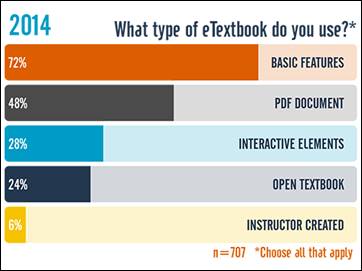


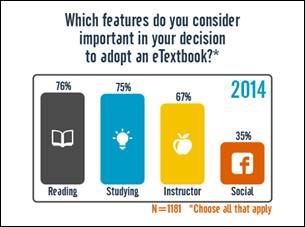

—————————–
Bossaller, J., & Kammer, J. (2014). Faculty Views on eTextbooks: A Narrative Study. College Teaching, 62(2), 68-75. doi:10.1080/87567555.2014.885877
http://login.libproxy.stcloudstate.edu/login?qurl=http%3a%2f%2fsearch.ebscohost.com%2flogin.aspx%3fdirect%3dtrue%26db%3dkeh%26AN%3d95094045%26site%3dehost-live%26scope%3dsite
Implementing eTexts into a Course:
- planning
- developing
- implementing
- delivering
This qualitative study gives insight into the experiences instructors have when working with publishers to integrate electronic content and technology into their courses.
Baek, E., & Monaghan, J. (2013). Journey to Textbook Affordability: An Investigation of Students’ Use of eTextbooks at Multiple Campuses. International Review Of Research In Open And Distance Learning, 14(3), 1-26.
http://eric.ed.gov/?id=EJ1017493
the Advisory Committee on Student Financial Assistance (2007) reported that textbook prices represent a significant barrier to students’ accessibility to textbooks. The report concluded that textbooks cost between $700-$1000 per year; textbook prices have risen much faster than other commodities; and that college aid fails to cover textbook expenses. Textbook costs are equivalent to 26% of tuition costs for an average four-year public university student and 72% of tuition costs for an average community college student. In fact, the California State Auditor (2008) reported that textbook costs grew more rapidly than student fees in academic year 2007–08.
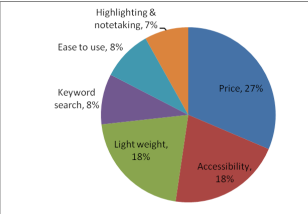
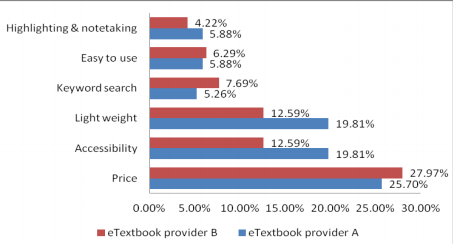
++++++++++++
Wimmer, E. e., Morrow, A. a., & Weber, A. a. (2014). Collaboration in eTextbook Publishing: A Case Study.Collaborative Librarianship, 6(2), 82-86.
http://login.libproxy.stcloudstate.edu/login?qurl=http%3a%2f%2fsearch.ebscohost.com%2flogin.aspx%3fdirect%3dtrue%26db%3dllf%26AN%3d108762075%26site%3dehost-live%26scope%3dsite
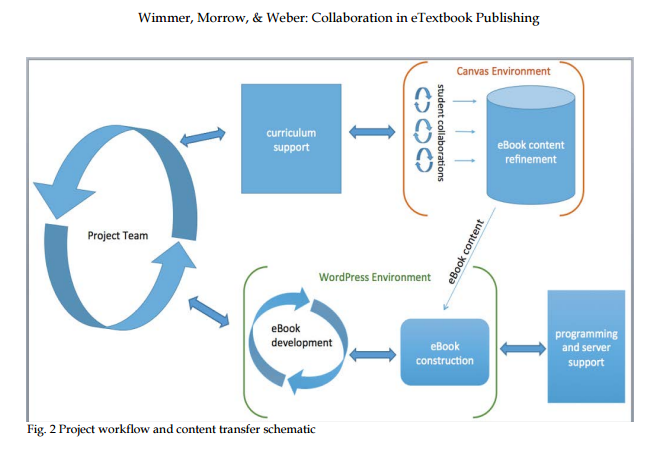
Distance education, e-learning, education and training. (2015). Clinical Chemistry & Laboratory Medicine, 53s557-s559. doi:10.1515/cclm-2015-5015
http://login.libproxy.stcloudstate.edu/login?qurl=http%3a%2f%2fsearch.ebscohost.com%2flogin.aspx%3fdirect%3dtrue%26db%3daph%26AN%3d102854748%26site%3dehost-live%26scope%3dsite
the creation of an interactive e-book called “Practical Clinical Chemistry: core concepts” was accomplished using the
Apple Macintosh platform and the iBooks Author software. Digital content, including videos, was developed for the
project and embedded within the final package. In order to limit the size of the final files, some content was uploaded
onto Youtube so that the user could access these via the internet.
The e-book, 200MB in size, was uploaded onto the Apple ITunes site and made available in 51 countries via the
iBooks store. This prototype is the first interactive digital textbook available in clinical chemistry and contains “4-
dimensional” content including digital images, videos, interactive presentations, real-time data generation as well as
review questions with instant feedback and assessment.
Hamedi, M., & Ezaleila, S. (2015). Digital Textbook Program in Malaysia: Lessons from South Korea. Publishing Research Quarterly, 31(4), 244-257. doi:10.1007/s12109-015-9425-4
Joseph, R. (2015). Higher Education Book Publishing-from Print to Digital: A Review of the Literature. Publishing Research Quarterly, 31(4), 264-274. doi:10.1007/s12109-015-9429-0
the author reflects the process on a state level (Ohio).
Marcoux, E. “. (2012). Best of the Best Planning. Teacher Librarian, 39(4), 69-70.
Taylor, A. K. (2011). Students Learn Equally Well From Digital as From Paperbound Texts. Teaching Of Psychology, 38(4), 278-281. doi:10.1177/0098628311421330
Much of the research related to digital texts has focused ontechnical aspects of readability (see Dillon, 1992, for a review) and limitations of digital media for note-taking, underlining, or highlighting text (Brown, 2001). However, the important—and unanswered—question from a teaching perspective is, ‘‘Can students learn as well from digital texts as from paperbound textbooks?’’ Few published studies have addressed this ques-tion directly, and even fewer studies have examined this ques-tion among college students.
Murray, M. C., & Pérez, J. (2011). E-Textbooks Are Coming: Are We Ready?. Issues In Informing Science & Information Technology, 849-60.
read the entire article, good data.
CourseSmart. FlatWorld Knowledge,
Horejsi, M. (2014). Textbooks 2.0. Science Teacher, 81(3), 8. http://login.libproxy.stcloudstate.edu/login?qurl=http%3a%2f%2fsearch.ebscohost.com%2flogin.aspx%3fdirect%3dtrue%26db%3daph%26AN%3d94603788%26site%3dehost-live%26scope%3dsite
++++++++++++++
pedagogy
two Eastern Europeans (Moldova, Serbia) raise serious concerns about electronic textbooks
Španović, S. (2010). PEDAGOGICAL ASPECTS OF E-TEXTBOOKS. Odgojne znanosti. 12(2). 459-470.
Railean, E. (2015). https://prezi.com/sbidiadctrzo/beyond-textbook-digital-textbook-use-and-development/
http://www.governance.ualberta.ca/en/GeneralFacultiesCouncil/CommitteeontheLearningEnvironm/~/media/Governance/Documents/GO05/LEA/15-16/WEB/Item-4-eTextbook-Subcommittee-Report-CLE-TLAT.pdf :
- (Un)desirable features in etextbooks
- How etextbooks might affect course delivery
- Pilot projects that can help build institutional expertise
- Address how and where insights gained from pilot projects will be collected and
- made available
- People resources (e.g., instructional designers) that will be needed to assist
- instructors to use this technology
ICWL (Conference) (13th : 2014 : Tallinn, E., & Cao, Y. (2014). New horizons in web based learning: ICWL 2014 international workshops, SPeL, PRASAE, IWMPL, OBIE, and KMEL, FET, Tallinn, Estonia, August 14-17, 2014, revised selected papers. Cham: Springer.
++++++++++++++++++++
MnSCU will by as Content Authoring Tool – SoftChalk. Here is a promo from Softchalk (my bold):
NEW SoftChalk Create 10 and SoftChalk Cloud eBook publishing features will arrive on April 25th! Come check out the latest enhancements at our upcoming webinars!
Sleek Designer Headers and Callout Boxes – Add some new pizazz to your SoftChalk lessons!
Three New Quiz Types – Test your students’ understanding with Sentence Completion, Multiple Blanks and Feedback Questions.
Polished New QuizPopper and Activity displays – With an enhanced interface for instructors and students.
Accessibility enhancements – Make your lessons available to everyone with even more accessibility enhancements.
NEW SoftChalk Cloud eBook creation and publishing – Includes a totally re-vamped, easier eBook creation and management. New SoftChalk eReader apps available for free download in the iOS, Android, Chromebook and Windows app stores. (Cloud Only)
+++++++++++++++++++++++++++
The future of textbooks looks like this
February 22nd, 2016
are any faculty really going digital? Which content distributors will thrive? What are the implementation concerns? And when will going digital really happen?
two massive surveys and reports by the National Association of College Stores (NACS) and the Independent College Bookstore Association (ICBA) in partnership with the Campus Computing Survey (CCS),
#MNsummit2015
Main speaker
Aaron Doering
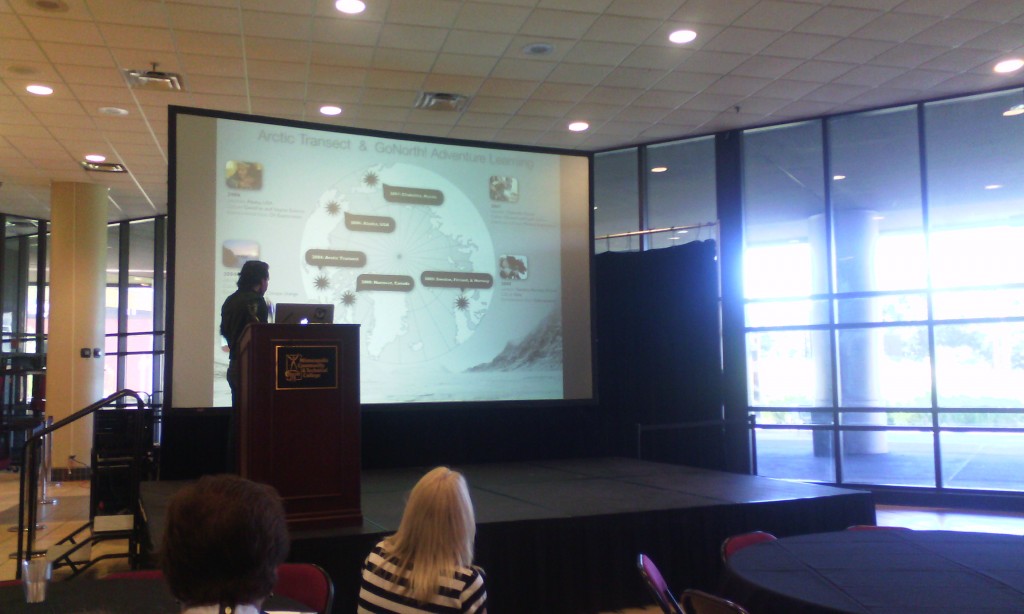
aaron doening
Engagement not completion
Design experience not product
Create change, not simply respond to it
He was a geography teacher : Dimitrina
Experience explore expand. Adventure based how to collaborate in ways we have not collaborated before pedagogical guidelines internet driven
Instructor – content – design
Today: first think is design, content, instructor. So how do we design learning environments is the most important one
Guide learners as designers. Constructivism. Design for meaning. Through the power of the story.
Geotetic design a learning environment learn geography using GIS
Situated movies (student-centered learning)
Grant Earthducation go to the most remote parts of the world to align their education with their culture, instead of what the government is downing as culture
Use of phone: whoever answers instructor’s question first, gets to pose the next question to the rest of the audience.
Design based research
Self-narrative, referencing the experience real world issues in real time
- reference knowledge . knowledge overlap. Technological pedagogical content knowledge.
Geotetic not only how prepare teachers, but desing learning environmwer of the story.
we explore: https://www.we-explore.com/
9.5 design as a learner.
the U Media Lab.
The Changing Earth. App GoX (instagram on steroids. tell their story through the app). How is this different from Google Earth
Raptor Lab (rehabilitate a raptor).
- design experiences
- build trust
- guide learners as designers
- recognize learners as experts
- encourage collaboration
- inspire self narrative
- reference the knowledge domains
- teach for change
- design as learner
adoering@umn.edi chasingseals.com @chasingseals
podcast pontification (audio version of blog self reflections)
Greg Steinke The U
A Digital Story Assignment using WeVideo
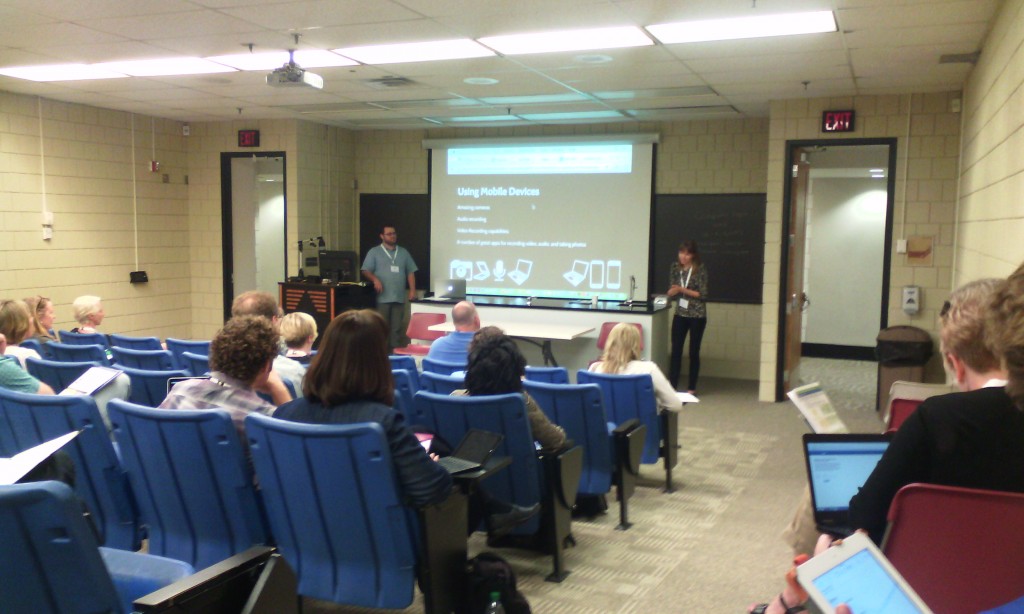
WeVideo is the Google response to iMovie cloud
The U is on Google email and thus google drive and all other google tools
The Center for Digital Storytelling. short videos, 3-5 min incorporate photographs with the author narration, reflection
Assignment (verbal directions). process (write a 2 page script, every page is about a minute of video), gather images that support the story; edit the script (rewrite); record audio to the script (use an app on the phone instead of WeVideo), WeVideo can edit the audio recording; edit the story, edit the photos to match the story; YourTube and/or Google+
working with faculty: is the digital story a good fit for your course? two questions: does the course have many writing assignments? does everyone have to do the same type of assignment? do you want to offer choices? do you want your students to share their work outside of the class? to you want to explore opportunities for students to develop 21 century skills?
google communities for sharing
wewideo has a tutorial at Center for Digital Storytelling
students can use the digital story for their eportfolio
the entire exercise is entirely based on mobile devices
time frame: scaffolding options
3d printing products were the tangible result of the project and the digital storytelling just the format to present
Google Drive master folder for the phone images and video; iOS apps: MoviePro, FiLMc Pro, VoiceRecord Pro (including mp3); Android: WeVideo
Storyboard template
Faculty Development Programs: Digital Storytelling Community of Practice
http://it.umn.edu/faculty-development-programs-digital-0
Poster sessions:
Brad Hokanson
http://dha.design.umn.edu/faculty/BHokanson.html
iPAD video kit:

Laurie Conzemius
Critical Thinking

ISTE: http://conference.iste.org/2016/
Joe Lau critical thinking
apps: Popplet blog.popplet.com http://www.popplet.com/ (mindmapping)
into the book: http://reading.ecb.org/
Kahoot – the token system. Polleverywhere https://blog.stcloudstate.edu/ims/2015/05/21/polls-and-surveys-tools-for-education/
Symbaloo https://www.symbaloo.com/home/mix/13eOcK1fiV zotero, easybib, delicious, diigo depending on the grade
youth voices; http://youthvoices.net/ replace social media like teachertube is trying to replace youtube
quandary games in education. https://www.quandarygame.org/ sim city
citizen science alliance http://www.citizensciencealliance.org/
Toontastic https://itunes.apple.com/us/app/toontastic/id404693282?mt=8 now free storytelling
coding and programming: https://www.makewonder.com/robots/dashanddot scratch
Osmo : https://www.playosmo.com/en/ $79.99 + give a set for free Stride principle as a parental involvement
chainlink;
kickword; https://play.google.com/store/apps/details?id=com.makario.wordkick
red herring (four categories) https://play.google.com/store/apps/details?id=com.BlueOxTech.RedHerring&hl=en
http://www.mathplayground.com/logicgames.html
http://www.mathplayground.com/thinkingblocks.html
evaluation:
telestory https://itunes.apple.com/us/app/telestory/id915378506?mt=8
explain everything http://explaineverything.com/
Exploring and Connecting 3D Printing to Teaching and Learning Jason Spartz, Saint Mary’s University of Minnesota
http://pubs.lib.umn.edu/minnesota-elearning-summit/2015/program/23/
http://pubs.lib.umn.edu/cgi/viewcontent.cgi?article=1023&context=minnesota-elearning-summit
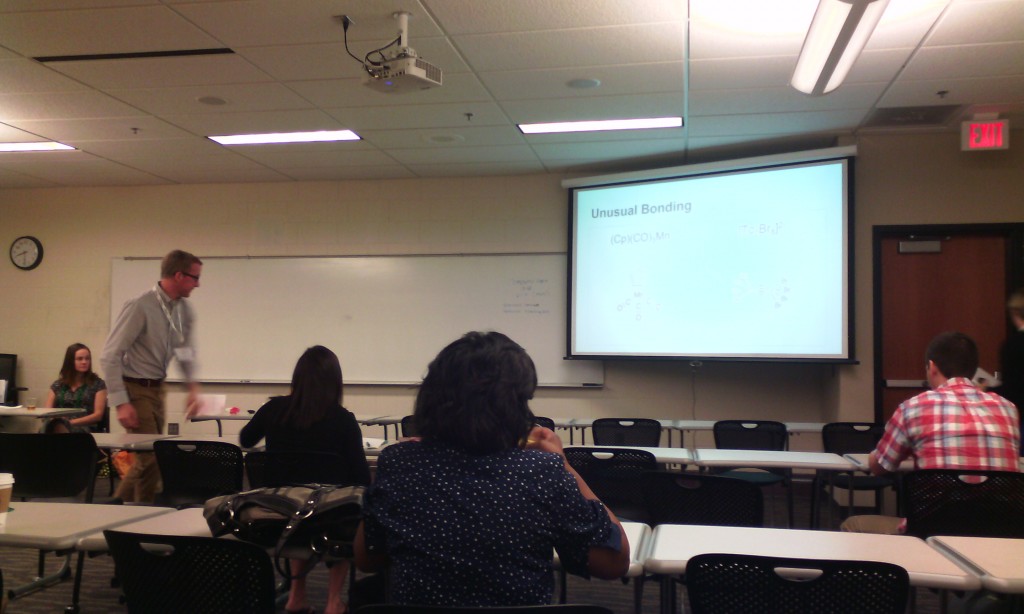
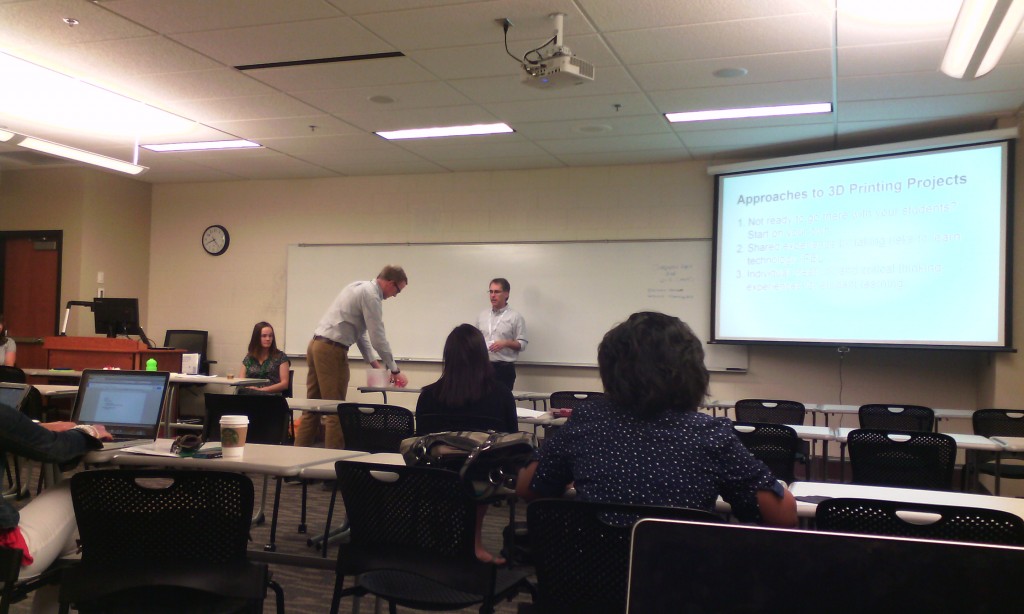
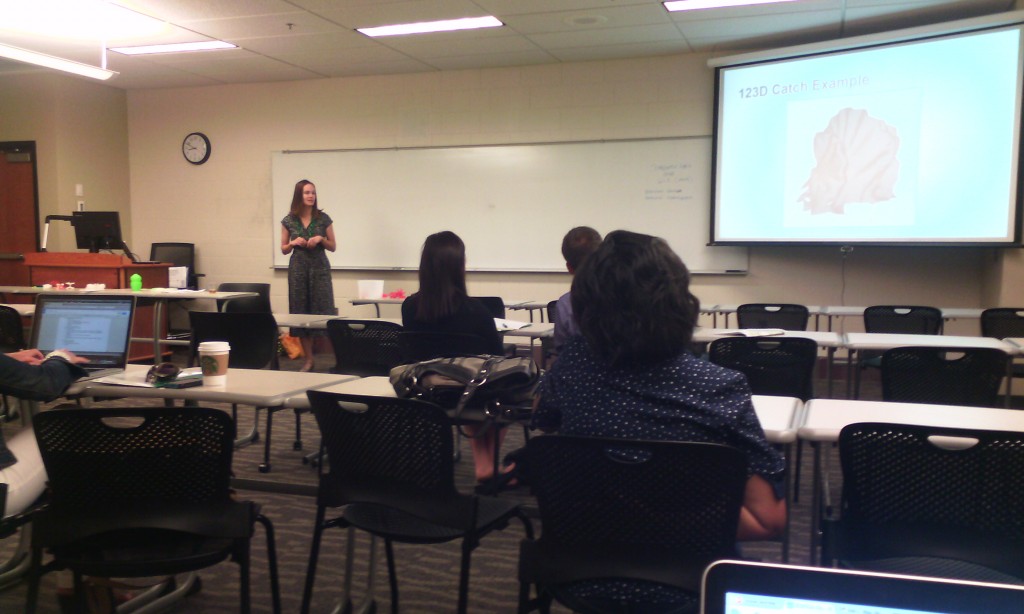
Jason Spartz, Saint Mary’s University of MinnesotaFollow
Lisa Truax, Saint Mary’s University of MinnesotaFollow
Karen Sorvaag, Saint Mary’s University of MinnesotaFollow
Brett Bodsgard, Saint Mary’s University of MinnesotaFollow
chemistry professor. 3D printing with different materials.
what else can be made (e.g. reaction vessel)
printing of atoms
crystalography dbase
Karen: pre-service teachers professor: how to use 3d printers and be comfortable with them. Steve Hoover. Thinkercad and Autodesk123D>
3D academy http://www.team3dacademy.com/index2.html. Pinterest board for3d Printing with resources
Lisa: graphic design. not intuitive. Rhinoceros (not free anymore). 123D strong learning curve. 3d printing will be incorporated in the curriculum. sculpture students and others don’t like fudging on the computer, but Adobe people love it. Some items takes up to 4 hours to print out. when working on the computer is difficult for some students to visualize the dimensionality.
collaborative learning opportunities.
no makerspace or fab lab. additional interest from the theater and business dept. 3d printing is connected to future work skills. new media ecology or media literacy set of skills.
the main presenter: build excitement and interest and gradually step back. how much material goes through and should we charge back. clean and maintenance involved; not too bad. better then a copier. plastic inexpensive. sizes with plastic – $25 and $50. how many project of a spool: depending on the size of the projects but considerable amount. two printers one art dept and one in the faculty dev area.
non profit visually impaired students. how 3d can make difference in special ed.
3d printing lab with access for everybody. ownership brings policy. where housed: neutral place.
only one printer is barely sufficient for faculty to figure out how to use it. purchasing two more if students and curricula to be involved.
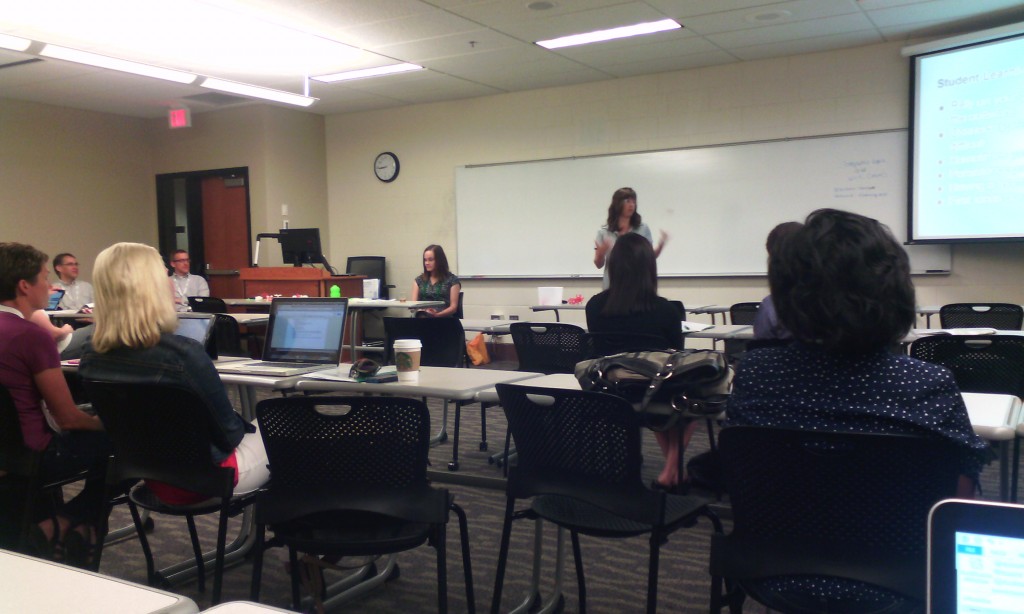



The Balancing Act: Team-Creating an eBook as an Alternative Method for Content Delivery Tom Nechodomu, University of Minnesota

Faculty Created digital stories – google “cultivaitng change series”
student created digital stories –
Susan Andre uses a slide titled “trust” to elucidate how the entire project was enabled. “trust” and “transparency” are sparse currency in the environment I work in. if she is right an ebook ain’t happening anytime soon at my place.
inclining habitat.
students involvement. use stipends. student artists. food for the video interviews. create a community, student centered.
people able to change the book.
copyright process; did you find it cumbersome. copyright permission center.
time span and amount of hours spent: 3-4 months per chapter.
Main speaker
David Wiley. Making Teaching and Learning Awesome with Open
MN Learning Commons
open educational resources
LUMEN
education – sharing feedback, encouragement with students passion about the discipline, yourself
open is not the same as free. free + permissions + copyright permission: 5 r = retain (make and own copies), reuse (use in a wide range of ways), revise (adapt, modify, and improve), remix (combine two or more), redistribute (share with others)
open:
free and unfettered access
perpetual, irrevocable copyright permissions
(look but don’t touch is not open)
tech enables OER permits
traditionally copyright materials on the Internet – not so good ; jet on the road
openly copyright materials on the internet _ yes: jet in the air
permission-less innovation. relatively inexpensive and broad permissions.
intellectual infrastructure of education: learning outcomes/objectives; assessments; textbooks. they are relatively expensive and narrow permissions.
disappearing ink strategies: buyback, rental, ebooks, online subscription
mad, glad, sad, rad: the grumpy cat. student success per dollar
opennetgroup.org/review
change in student learning: replace commercial with open books – small. realign, bigger change. rethink is the large change.
responsibilities:
attribution and meeting other license requirements
thin common cartridge: a way to bring the content to the CMS, but the content remains on the creative commons
disposable assignment: students hate doing them, instructors hate grading them. waste of time and energy
so what?
open education infrastructure: open outcomes, objectives, activities, educational resources
the culture of glued legos must be eradicated. open pedagogy. open credentialing model
summary: don’t settle for “affordable.” improve student outcomes. improve affordability. improve design / academic freedom
links generated from the discussion at my presentation:
http://podnetwork.org/event/pod-2013/
Conference program available in PDF and upub format, so I can have it on my laptop and on my mobile device: diminishes the necessity to carry and pull constantly a paper stack.
it is the only conference I know with 6AM yoga. Strong spirit in a strong body. LRS & CETL must find space and instructors an offer mediation + yoga opportunity for SCSU students to disconnect
1:00 – 5:00 PM excursion to Carnegie Mellon – Learning Spaces. LRS interest in Learning Commons.
From the pre-conference workshops, Thurs, Nov 7, 8:30AM – 12:00PM:
Linda Shadiow, Connecting Reflection and Growth: Engaging Faculty Stories.
This workshop seems attractive to me, since it coincides with my firm conviction that SCSU faculty must share “best practices” as part of the effort to engage them into learning new technologies.
Kenyon, Kimberly et al, Risky Business: Strategic Planning and Your Center.
This workshop might be attractive for Lalita and Mark Vargas, since strategic planning is considered right now at LRS and CETL might also benefit from such ideas.
roundtables, Thurs, Nov. 7, 1:30-2:45PM
Measuring the Promise in Learner-Centered Syllabi
Michael Palmer, Laura Alexander, Dorothe Bach, and Adriana Streifer, University of Virginia
Effective Faculty Practices: Student-Centered Pedagogy and Learning Outcomes
Laura Palucki Blake, UCLA
Laura is the assistant director http://gseis.ucla.edu/people/paluckiblake
3 time survey of freshmen. survey also faculty every 3 years. can link this date: faculty practices and student learning
triangulating research findings. student-centered pedagogy. which teaching practices are effective in promoting student-center learning practices.
no statistical differences in terms of student learning outcomes between part-time and full-time faculty. The literature says otherwise, but Laura did not find any statistical difference.
http://ow.ly/i/3EL77
discussions is big, small group work is big with faculty
in terms of discussions, there is huge difference between doing discussion and doing it well.
this is a self-report data, so it can be biased
there are gender differences. women more likely to use class discussions, cooperative learning same, students presentations same. gender discipline holds the gender differences. same also in STEM fields.
students evaluations of each other work. cooperative learning: it is closer gender-wise.
the more student-centered pedagogy, the less disengagement from school work.
understand on a national level what students are exposed to.
lpblake@hmc.edu
http://www.heri.ucla.edu/
wabash national data.
ePublishing: Emerging Scholarship and the Changing Role of CTLs
Laura Cruz, Andrew Adams, and Robert Crow, Western Carolina University
LORs are in Kentucky.
CETL does at least Professional Development, Resources, Eportfolios, LORSs. FLCs
Teaching Times at Penn.
model 2: around instructional technology. More and more CETL into a combined comprehensive center. about 9 are paid by IT and 11 by academic center. because of finances cuts this is the model predicted from the 90s. Why not IT? because ater they say how to use it. and how to use it effective. think outside of technology, technogogy is not the same as technology. Teacher-scholar model: research, service, teaching.
http://ow.ly/i/3EMJl
egallery and other electronic ways to recognize productivity. Stats and survey software does NOT reside with grad studies, but with CETL, so CETL can help faculty from a glimmer of an idea to presentation and publication. Research Support Specialist.
how and where it fits into faculty development. Neutrality. Should CETL be advocates for institutional, organizational change. Do CETL encourage faculty to take innovation and risk (change the culture of higher ed). Tenure and promotion: do we advocate that epub should count, e.g. a blog will count toward tenure.
a national publication: http://www.sparc.arl.org/resources/authors/addendum
we domenstrate that it is good school. scholarship of teaching will be good teaching.
OER? Open educational resources. SHould CETL host and participate in those? Do we participate in creating resources, which are designed to replace texbooks? Caroline has a state-wide grant to support faculty developing learning resources.
open access is controversial. the right to publish and republish. http://www.sparc.arl.org/
40% of all scholarly articles are owned by 3 publishers
Academic Social Media academic.edu and electronic journals.
CETL is the comprehensive center, the hub where people go to, so CETL can direct them to and or get together stakeholder to make things happen.
the lesson from this session for me is that Lalita and Keith Ewing must work much closer.
Evaluating the quality of MOOCs: Is there room for improvement?
Erping Zhu, University of Michigan; Danilo Baylen, University of West Georgia
reflection on “taking” a MOOC and the seven principles. how to design and teach MOOC using the seven principles.
MOOC has a lot of issues; this is not the focus, focus is on the instructional design. Both presenters are instructional designers. Danilo is taking MOOC in library and information science.
Second principle: what is a good graduate education.
about half had completed a course. Atter the 3rd week the motivation is dissipating.
Erping’s experience: Provost makes quick decision. The CETL was charged with MOOC at U of Michigan. Securing Digital Democracy. http://www.mooc-list.com/university-entity/university-michigan
Danilo is a librarian. his MOOC class had a blog, gets a certificate at the end. Different from online class is the badges system to get you involved in the courses. the MOOC instructors also had involved grad students to monitor the others. the production team is not usually as transparent as at Corsera. Sustainability. 10 week module, need to do reflections, feedback from peers. 7 assignments are too much for a full-time professional.
http://www.amazon.com/Library-2-0-Guide-Participatory-Service/dp/1573872970
http://tametheweb.com/category/hyperlibmooc/
http://tametheweb.com/2013/10/20/hyperlibmooc-library-2-013-presentation-links/
1. principle: contact btw faculty and student. Not in a MOOC. video is the only source provides sense of connection. the casual comments the instructor makes addressing the students provides this sense. Quick response. Collaboration and cooperation in MOOC environment and bring it in a F2F and campus teaching. Feedback for quizzes was not helpful to improve, since it i automated. students at the discussion board were the one who helped. from an instructional design point of view, how MOOC design can be improved.
group exercise, we were split in groups and rotated sheet among each other to log in response to 7 sheets of paper. then each group had to choose the best of the logged responses. the responses will be on the POD site.
eri week resources
Per Keith’s request
“Why Students Avoid Risking Engagement with Innovative Instructional Methods
Donna Ellis, University of Waterloo”
Excerpt From: Professional and Organizational Development Network in Higher Education. “POD Network 2013 Conference Program, Pittsburgh PA 11/7 to 11/10.” iBooks.
This material may be protected by copyright.
A quantitative study. The difficulty of group works. Various questions from the audience, the time of class (early Mrng) is it a reason to increase the students disengagement. Students pereceptions .
The teacher did. It explain why the research and this might have increased the negative perception. Summary of key barrierS.
Risk of negative consequneces
preceived lack of control
contravention of perceived norms.
fishbein and Aizen 2010
discussoon . How faculty can design and deliver the course to minimize the barriers. Our table thought that there are a lot of unknown parameters to decide and it is good to hear the instructor nit only the researcher. How to deal with dysfunctional group members behaviors. Reflections from the faculty member how to response to the data? Some of the barriers frustrated him. Outlines for the assignments only part of the things he had done to mitigate. What are we asking students on course evaluations. Since a lot more then only negative feedback. Instructor needes more training in conflict resolution and how to run group work.
http://ow.ly/i/3Fjqt
http://ow.ly/i/3Fjpq
CRLT Players
Friday, Nov 8, 10:30 AM – 12:00 PM
William Penn Ballroom
7 into 15
CRLT Players, University of Michigan”
Excerpt From: Professional and Organizational Development Network in Higher Education. “POD Network 2013 Conference Program, Pittsburgh PA 11/7 to 11/10.” iBooks.
This material may be protected by copyright.
It is a burlesque and theater approach to engage students and faculty into a conversation. 10 plays in 30 min.
Discuses different topics from the plays and seek solutions as a team. How to deal with international students ( Harvard lady said ” safe places” for students) how to deal with technology or the lack of it, missed next one writing this notes and how to reward faculty in innvative things. T. Encoruage innovation, they received a letter from the provost and if they fail, it is not used in their annual evaluation
No videotaping of this performance because the power is in conversation. Is there a franchise, like training people to do that. NSF grant was allowing them but now just pick up the idea. Sell scripts? Can have conversations about strategies how to collaborate with the theater department where to start these short vinniets. If come to campus and bring performance do they do also the follow up.
Is anger or hostility a reaction during after these presentations. How to handle it. Hostility can be productive and make sure that it is told that it is productive. Getting difficult things out there is what the theater is trying to do in a distant way. This is not a morality
how develop the work? How come up with issues. Faculty bring issues, followed by interviews, draft created we heater identifies the problem and address the issue. Preview performances with stakeholders who confirm . There are more then. Sufficient ideas, so the organizers can choose what they see most pertinent
ecrc committee went to their meeting instead of lunch to see if I can particpirate for next year activitities. Ecrc is the acronym for the tech committee. Web site is one takes of this committee. Word press site , how the groups work, how forms work, how to connect with people and most importantly how to start communicating through the web site and cut the listserv. An attempt to centralized all info in the website rather then scattered across universities.
what is BRL? Google apps and Wikipedia as a wiki for another year until figure out if it can be incorporated in the web site. Reconceptualize how do work in the process. To groups in ecrc. Wikpaidea and web page. And then social media with Amy? Ecrc liaison in every POD committee to understand how to set up the committee web presence. Blackboard collaborate to do meetings and this is what liason explain to committee members. Tinyurl.com/ECRC2013
Designing Online Discussions For Student Engagement And Deep Learning
Friday, Nov 8, 2:15 PM – 3:30 PM, Roundtable
Parkview East
Danilo M Baylen, University of West Georgia”
pit must be asynchronous discussion
What is the purpose and format of the discussion. Assessment. How the online discussion is supporting the purpose of the curriculum to the students learning
About five discussions per semester all together. Behaved part of the class culture
Format of the assignment
asynchronous discussion list. Series of questions or a case study. Is the format a sequence of responses or invite a discussions
checklist which stifles a creative discussion or just let it more free
purpose – must be part of the syllabus and it must be clear.
Meeting learning objectives.
duration
interactivity – response to other students. List of 6 different options how they can reply. what format the interactivity takes Is important issue, which has no textbook
assessment- initial posting are critical, since it gives and idea what to work on. How much points as part of the bigger picture. Yet it is the ground work for the assignment, which gets most points.
metacognitive not evaluative , give students examples from the pro regions class what a good discussion is And explain students how to. Evaluate a good discussion entry
how the question is worded and use the threaded discussion for them to reflect how they think, rather then only assess if they read the chapter. The research about online discussion is very different.
What is the baseline.
Online course must must be set up ready before semester starts or not?
reflection for the end of the semester
SteVn brookfields critical questionaire
meet thISTI and qr standards
is reflection on the content or the process
students reflect on their own reflections
what have you learned about yourself as online learner and look for consistencies for both negative and positive reflections
Assess critical thinking
there is a workshop by the presenters instituitions how to organize
more claims then actual evidence so Data is sought to
main issues
programmatic emportfolio. Not student presentation portfolios, but academic portfolio
e portfolio forum
look at image of the green copy:
1. Integration and reflection
2. Social media – in community with other students , faculty, organizations
3. Resume builder
eportfolio is. Prt of the assessment. Conversation on campus. Some depts use exportfolio extensively but not happy. Programmatic academic e portfolio to collect data
use Sakai open portfolio system
12 drepartments and six more second year. to speak the same language, they developed a guideline, conceptual framework ( see snapshot of handout)
Curriculum mapping ( see the grid on the. Handout) took much longer then expected.
the role of CETL. The provost at Kevin’s institution charged CETL to do the portfolio gig.
The big argument of the CETL redirector with the provost is that portfolio not only to collect data for assessment and accreditation but to provide meaningful experience for the students. EDUCAUSE report horizon, learning analytics Scandalous headlines of students suing law schools. bad deductions made on big data. The things that matte for students must be in the portfolio and they get used to use the portfolio. Pre reflection entries by the students, which shorted the advising sessions. The advisor can see ahead of time. The advisers. Will. B the. Focus point, The. Advising portfolio Is becoming
portfolio must be used by faculty not only students.
Whats the by in for students. Presentations portfolio part of. Marketing purposes. Google sites so when students leave the institutions students can ” take” the portfolio with them as we’ll go multimedia. attempts failed because platforms which can be cutozmized we’re not used Digital identity As CETL director not technology expect and how to learn from the faculty and that was very
documenting and learning with eportfolios.
faculty to demonstrate reflections to students and how enter into portfolio. Using rubrics. Faculty are using already tools but connecting with. Reflections.
STAR: Situation , tasks, action, response
Writing skills differentiate, but even good writers got better on reflection
how one polish a portfolio before bringing to an Employer. Student Working with career services to polish and proofread.
How much the university is responsible for an individual portfolio. How many levels of proof reading.
Poor student work reflects a poor faculty attention.
Lorna Kearns, University of Pittsburgh”
Freedom to Breathe: A Discussion about Prioritizing Your Center’s Work
Andy Goodman and Susan Shadle, Boise State University
Connecting, Risking, and Learning: A Panel Conversation about Social Media
Michelle Rodems, University of Louisville. Conference C 9:00 AM – 10:15 AM
The use of social media in higher education
Conference C 9-11:15 AM
Panel of CETL directors and faculty. The guy from Notre dame uses word press the same way I use it. Collect questions and after the 3rd one creates blog entry and answers the next q/ s with the URL to the blog entry NspireD is the name of. The blog
the OHIO state UCAT guy is a twitter guy. Program coordinator who manages wordpress and web site. Intersect with FB and twitter. Platforms are inteGrated, so be did not to know the technicalities. The graduate consultants are setting up. ciirdinator tried to understand how the mesh together. Can be used as conversation starters or to broadcast and share info. Use of hashtags how to use them appropriate in twitter and FB to streamline .
Scsu problem. W don’t build it they will not come. a Tim burton version of the field of dreams.
Rachel CETL assist dir at U of Michigan. She is out there personally likes it. Very static web page. Drupal as a content management system so the blog is part of the web page. So 2 times a week entries. One of the staff people is an editor and writes blog posts, but vetted by a second CETL staff. Auto push for the blog to the twitter. Screencasts for YouTube channel with screencasts. Comments on the blog minimal from faculty and stat. What about students? About 1000 followers on the twitter. What do analytics say. Hits on home page, but no idea how much time reading. The time people spend more time and using the tags . the use of blog is less formal way to share information. recycling in December and August a lot of material.
does anybody subscribe and do you promote RSS
the separate blog for a workshop requires interaction and that is a success
for faculty development U of Michigan is using blog recruited 50 to follow the blog. TSam of 3 using. WordPress For a semester and then survey. Focus group. Huge success, between 6 and 30 comments. Community with no other space on campus
how are u using social media to promote connections. elevate voices of others on campus by interviewing faculty. At U of Michigan there was no interest to learn about what other faculty are doing. So they trashed that initiative but starTed a video narration about faculty who innovate. Videotaped and edited no hi Qual video , tagged and blog posted and this approach created more connection, because it is not text only.
What have been the obstacles and indoor failure and what have you learned?
convincing the administration that CETL than do it and it does not have to be the same quality as the web page and the printed material. Changing the mindset. No assessment, since nothing else was working and they were ready for radical step such as blog
Same with the twitter. Taking the risk to experiment with the hashtags. Tweets can’t be approved. Need to time to build an audience, one month will not have an impact. Start with the. Notion that you are building a reposIvory noT a foRum
one of the panelist has a google spreadsheet which has information of allCETL social media sites There are resources on how to deal with negative outcomes of using social media. Working with librarians, the Norte dame said! they will give you twenty sources. No no, no, he siad, give me your best three.
U of MichiGan more grad studns blog guest posts almost no faculty.
Have you considered giving them more then guest blog, but no facilitator? Let faculty once a semester do a blog post. It is not moderated but more like lead to how to do a good blog. Interview based approach is unique and does not show up somewhere elSe.
Insitutional background important in these decisions.
How often refresh the wordpress page. How often one person is voicing and it takes a log of journalistic skills. Use the draft option to publish when there are several ideas coming at once.
Mindshift of CETL is to decrease the standards. Make it more informal. Blog post can be always fixed later. To avoid faculty false perception that this is not scholarly needs to be references. So causal tone + references.
Blog ” from students perspective” is repurposE
Risking Together: Cultivating Connection and Learning for Faculty Teaching Online
Michaella Thornton, Christopher Grabau, and Jerod Quinn, Saint Louis University
Oliver 9-11:15 AM
Space Matters! and Is There a Simple Formula to Understand and Improve Student Motivation
Kathleen Kane and Leslie A. Lopez, University of Hawaii at Manoa
Riverboat 9:00 AM – 10:15 AM
The Risks and Rewards of Becoming a Campus Change Agent
Dr. Adrianna Kezar, University of Southern California
William Penn Ballroom 10:30 AM – 12:00 PM
Branch campuses, students abroad, to more with less, completion from profit institutions
students work more but this is a good reflection on learning success
provost might ask to consolidate prof development opportunities for faculty and students instead of faculty only.
If administration is genuine understand transparent Administration more about persuading not listening. Respect, not assuming that faculty will not accept it. If faculty will sacrifices what will faculty see the administration sacrifice on their side. Leading from the. Middle , it means collective vision for the future. Multilevel leadershup, top down efforts dont work and bottom top are fragile. Managing up is less preferred then powering up. It is difficult to tell administration that they miss or misunderstand the technology issue.
Four frames. Goal multi frame leadership http://www.tnellen.com/ted/tc/bolman.html. Vey much the same as Jim Collins good to great right people on the bus right trained http://www.afa1976.org/Portals/0/documents/Essentials/Creating%20Organizational%20Learning%20and%20Change.pdf
How to build coalition, different perspectives, aknowledge the inherent conflict.
The Delphi project
It Takes a Campus: Promoting Information Literacy through Collaboration
Karla Fribley and Karen St. Clair, Emerson College
Oakmont 1:45 PM – 3:00 PM
Most of the attendees and both presenters were librarians
The presenters played a scatch to involve the particppaints
deifnition what is IL. https://mobile.twitter.com/search/?q=%23POD13&s=hash
http://ow.ly/i/3G00e/original
Information literacy collaborative work with faculty to design student learning outocmes for information literacy
Guiding principles by backward course design
Where they see students struggle with research
question to students survey, what is most difficult for your and wordle.
http://ow.ly/i/3G0l6/original
self reflection ow.ly/i/3G0UH
Curriculum mapping to identify which courses are the stretigic ones to instill the non credit info litreacy
acrl assessment in action
Risky Business: Supporting Institutional Data Gathering in Faculty Development Centers
Meghan Burke and Tom Pusateri, Kennesaw State University
Oliver 1:45 PM – 3:00 PM Roundtable
Exploring Issues of Perceptual Bias and International Faculty
Shivanthi Anandan, Drexel University.
Heinz 3:15 PM – 4:30 PM Roundtable
Why do we need it and onoy regarding international faculty don’t in Kim Lisa wolf-wendel
susan twombly. Pointers for hiring and retention. Performance is both teaching and living. Sanitary effect. sanitary issues not only pay rate. FLC all tenure track without citizenship they are worried about their tenure. Funding agencies, very few will fund you if you are not a citizenship
Diane Schafer perceptual biases, graffiti. Cathryn Ross
Averting Death by PowerPoint! From Killer Professors to Killer Presenters
Christy Price, Dalton State College
Riverboat 4:45 PM – 6:00 PM
How to create effective mini lectures checklist for acting palnning
engage and leave lecture out. The reason why can’t move away is because some people lecture as performance art
Make lectures mini. How long mini should be. 22 min, the age number of the person.
Emotional appeal, empathy.
Evoke positive emotions with humor. Always mixed method research, since the narrative Berk, r. (2000) and Sousa (2011)
ethical. Obligations and emotional appeal
acknowledge the opposition
enhance memory processing with visuals and multimedia
use guided practice by miniki zing note taking
presentationzen is a book! which need to read http://www.barnesandnoble.com/w/presentation-zen-garr-reynolds/1100391495?ean=9780321525659
Enchanted memory processing by creating mistery
address relevance
http://advanceyourslides.com/2011/01/28/the-5-most-memorable-concepts-from-nancy-duartes-new-book-resonate/
Death by PowerPoint: Nancy Duarte: The secret structure of great talks
http://www.ted.com/talks/nancy_duarte_the_secret_structure_of_great_talks.html
http://www.gobookee.org/get_book.php?u=aHR0cDovL3d3dy5vcGVuaXNibi5jb20vZG93bmxvYWQvMDQ3MDYzMjAxMS5wZGYKVGl0bGU6IFJlc29uYXRlOiBQcmVzZW50IFZpc3VhbCBTdG9yaWVzIFRoYXQgVHJhbnNmb3JtIC4uLg==
Engage faculty by showing. Faculty how their presentation. Is. And how it c can be
process with clickers
Sunday Mrng session
vygotsky zone of NAND the flipped mindset. http://t.co/vCI8TOJ7J2. Cool tweets at #pod13.
Ideas process baudler Boyd stromle 2013
I – identify the issue
D debrief the situation
A analyze what happened
s strategize solutions and Oport unities for growth and future success

















